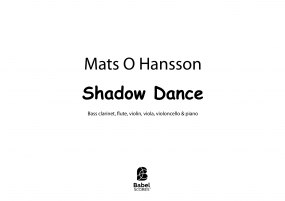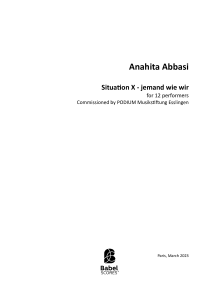Les Sept Vitraux du Château Intérieur
ISMN : 979-0-2325-5872-1
- Login to create your own lists
Version actualisée et concentrée à partir de la composition pour le spectacle The Interior Castle - Compagnie Musica Aperta pour le 500ème anniversaire de la naissance de Sainte-Thérèse d’Avila Création mai 2015 - Boston États-Unis.
///
Présentation =>
Les 7 mouvements de l’oeuvre - les 7 Vitraux - sont à considérer comme des haïkus sonores. 7 phrases-respirations lumineuses venant éclairer la temporalité de l’oeuvre (métaphore ici du Carmel). L'itération - révélation mystique tout autant que questionnements et combats - des matériaux musicaux mis en oeuvre devient Vitrail. Ces 7 Vitraux subissent tout au long du spectacle une transformation de la matière : de la densité à l'éthéré, du dispersé à l’uni. Ils se répartissent en 4 états de transformation : calme, pré-questionnement / ténèbres, charnel démoniaque / tentation, assaillement, questionnement, doute, charnel tourmenté / apaisement, résolution, lumière, sereinité.
Dès le début, et globalement, l’ensemble instrumental cherchera à restituer le son flûté d’un orgue positif à l’exception de quelques parties pour lesquelles s’imposent un certain lyrisme (con vibrato ma non tropo). Les cordes joueront continuellement arco tasto (molto) flautando non vibrato à l’exception de quelques parties pour lesquelles s’imposent une certaine emphase. Ces 7 phrases-respirations sont à interpréter (donc à vivre) dans l’esprit des neumes (grand mélisme émis d’un seul souffle). La temporalité des espaces (silences) au sein de ces 7 phrases-respirations sera appréciée librement par les musiciens. L'oscillation d'amplitude demandée de-ci de-là aux violoncelles et à la clarinette basse, est à considérer comme une libre et lente inspiration-expiration entre pp(p) et p(p). Les glissandi indiqués seront toujours con legno tratto et ne devront en aucun cas être perçus comme anecdotiques.
///
The musical work Les sept Vitraux du Château Intérieur (The Seven Stained Glass Windows of the Interior Castle), composed specifically for the The Interior Castle, displays the contrasting color in my approach to the composition: to portray the nature of sound between Renaissance and Contemporaneity, exposing a relationship between
History and Modernity. The seven movements within the musical work—seven breathed phrases in the form of sonorous haïkus—were conceived as seven luminous stained glass windows illuminating the Temporality of the performance (Temporality being a metaphor for the Carmel spirituality). The iteration of the musical material throughout the Temporality is as much a mystical revelation as a questioning—almost a violent internal conflict. Within the spirit of their substance The Seven Stained Glass Windows, interpreted by the instrumental ensemble like neumes, undergo a transformation throughout the performance: from dense to ethereal, from dispersed to unified, from finite to infinite.
They can be divided into four states of transformation: 1) Calm and early self-questioning, 2) Darkness, carnal and demonic 3) Temptation, internal aggression, total questioning, doubt, carnal and tormented, 4) Peace of mind, resolution, serenity, light. A certain impression of cold light emerges from the violins and cellos playing senza vibrato, thus causing the musical text to “draw within”. Gradually a lyricism unfolds leading us toward warm light. The musicians take full liberty within the space Temporality, applying musicial rests in such as way that we feel the inhaling and exhaling of the God-breathed Word. Volume’s oscillations sometimes asked (cello and bass clarinet) are like slow inspiration - expiration between pp(p) et p(p). Glissandi will be con legno tratto and will never be regarded as anecdotic.
Pages - 20








